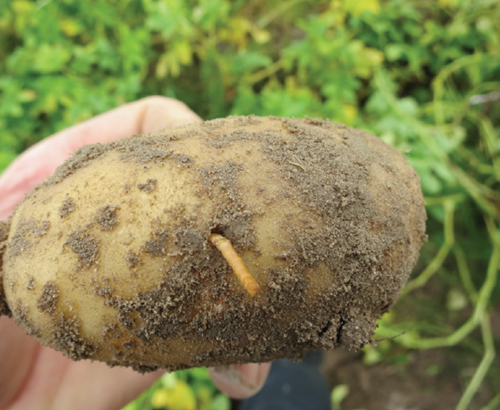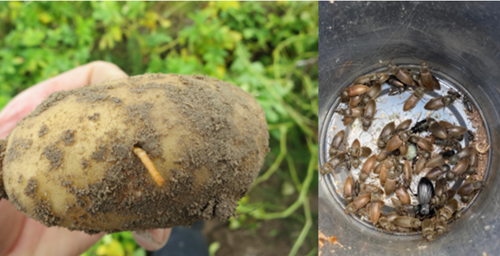Wireworm: Safeguarding Your Crops

As potatoes are a high value crop, it stands to reason that there is a high level of scrutiny on pests and diseases which affect them, however, there are several pests which feed on other crops as well as potatoes. One of these is wireworm - small, soil borne orange/yellow larvae of click beetles (Figure 1, left). Wireworm feed on potato crops by burrowing into the tuber and at high incidence rates, can render a crop unusable for markets such as packing for supermarket shelves. Wireworm damage is not limited to potatoes; these pests can also cause major damage to cereal crops like wheat, barley, and maize, as well as a wide variety of vegetables, including carrots, lettuce, and radishes.
What Does Wireworm Damage Look Like?
In potatoes, damage consists of tubers with small burrow holes. These can vary in depth into the tuber however, they are relatively straight when compared to holes made by some other pests e.g. slugs. In cereals, wireworm will feed on the plant material below the surface. This damage will stunt older plants, causing yellowing and wilting, and killing off younger, more vulnerable plants. The result? A clear reduction in crop yields.
Risk Factors
Wireworm infestations in Scotland are on the rise. Traditionally associated with long-term grassland, infestations are now being found in fields that haven’t seen grass for decades. The increase in cereal crops in rotations - a common practice to manage tighter margins - provides an abundant food source for wireworm, exacerbating the problem. Unmanaged grass margins and high grass-weed burdens further compound the risk.
Regenerative agricultural practices, such as introducing flower strips, may unintentionally create safe havens for wireworm. While these strips boost populations of beneficial insects, their impact on wireworm populations remains unclear. The Plant Health Centre project aims to address these knowledge gaps to help farmers make informed decisions.
How Can We Work Against Wireworm in the Field?
The first step in managing wireworm is understanding the status of your fields. Thankfully, wireworm are somewhat easy to test for. If you have an established cereal crop, it may be as simple as lifting a few test digs and sifting through the soil around the roots of the plants. It is possible to get wireworm confused with other similar looking insect larvae. If you spot any that make you concerned you can get in touch with an SAC consultant who can help with testing and identification. Bait trapping (for the wireworm larvae) in a field can be done pre-planting in spring or post-harvest in autumn. Pheromone traps (for the adult click beetle) can be set up in field throughout the growing season regardless of crop (potato or cereal) (Figure 1, right).
Appraising current field practice is always the first place to start when trying to manage an established infestation. In more severe cases, chemical interventions like Nemathorin 10g for potatoes or the insecticide active substance cypermethrin in seed treatments for cereals may be necessary. By addressing infestations early and strategically, you can protect your yields and profits.

Figure 1. Left - Wireworm larvae protruding from damage hole in potato tuber. Right - Contents of an infield pheromone trap (click beetles are the numerous brown species present).
This year’s SAC Association of Potato Producers (SACAPP) Conference will feature an update on our wireworm research, including practical insights and Integrated Pest Management strategies specific to Scotland. For more information, contact SACAPP@sac.co.uk.
Top Tips:
- Know your status: Test your fields if you notice signs of wireworm or damage to your crops
- Evaluate practices: Practice good weed management across your rotation to reduce grass weeds which can increase your risk of wireworm
- Weed control: Implement effective grass-weed management across rotations
- Seek expert advice: For tailored guidance, reach out to Kerry Leslie at Kerry.Leslie@sac.co.uk.
Dr Kerry Leslie, Potato Consultant, Kerry.Leslie@sac.co.uk

Unearthed is the exclusive SAC Consulting members' monthly newsletter. Unearthed offers insights and tips from our experts on what we think is in store for farming and crofting in the coming months in order to protect and enhance your business.
Posted by Unearthed News on 20/01/2025
